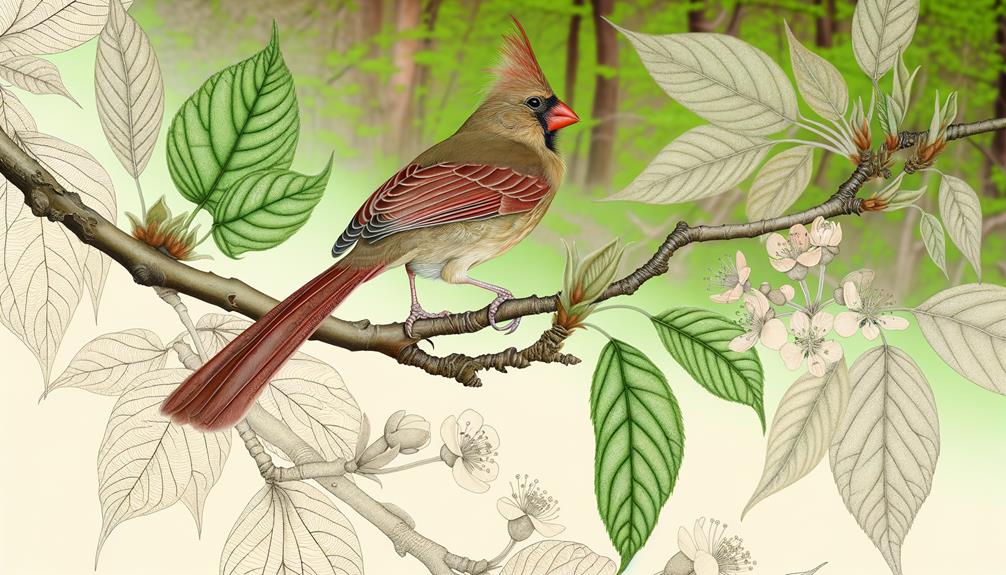7 Steps to Draw a Female Cardinal
To draw a female cardinal, start by gathering high-quality paper, graphite pencils, and colored pencils. Study the bird's anatomy carefully, paying special attention to the less vibrant red highlights and distinctive crest.
Begin sketching basic shapes using ovals for the body and a small circle for the head. Add a triangle for the beak and outline the crest.
Refine your outline, ensuring accurate proportions and alignment of wings. Add feather details with fine lines and texture.
Apply a light brown base coat, then layer muted red and gray shades. Practice shading for a lifelike appearance.
Keep learning for more refined techniques.

Key Takeaways
- Start by sketching basic shapes like ovals and circles to define the body, head, and beak.
- Refine the outline, focusing on the crest, rounded body, and proper wing alignment for realism.
- Add fine lines to outline feather patterns and use varied strokes to create texture and depth.
- Incorporate colors with a light brown base, adding warm red accents and muted grays for a natural look.
- Use a kneaded eraser and fine-tipped pen to refine details and enhance the lifelike appearance.
Gather Your Materials
To start drawing a female cardinal, you'll need a few essential materials to guarantee accuracy and detail in your artwork.
Begin with high-quality paper, preferably a smooth, acid-free type for clean lines.
You'll also want a set of graphite pencils in varying hardness levels, ranging from H to B grades, to achieve different shades and depths.
Don't forget a good quality eraser, like a kneaded eraser, for refining details without damaging the paper.
A fine-tipped black ink pen will be useful for final outlines.
It's also handy to have colored pencils or watercolors to bring the vibrant hues of the female cardinal to life.
Study Cardinal Anatomy
Delving into the anatomy of a female cardinal, start by closely examining its distinctive features, such as the crest on its head, the shape of its beak, and the subtle coloration differences compared to males.
Notice how the female's crest is often more subdued in color, blending into her tan or brownish-red feathers. The beak is robust and conical, ideal for cracking seeds.
Pay attention to the slightly less vibrant red highlights on her wings and tail, contrasting with the male's bright red plumage.
Observe her rounded body and short, stout legs, which contribute to her distinctive silhouette. Understanding these details will help you capture the essence of the female cardinal in your drawings.
Sketch Basic Shapes
Start by outlining the cardinal's body structure using simple shapes like ovals and circles to represent the torso and head.
Then, define the head shape by sketching a smaller circle atop the body, ensuring it's slightly tilted to capture a natural pose.
Outline Body Structure
Begin by sketching a small oval for the head and a larger, rounded shape for the body to establish the general proportions of the female cardinal. Position the head slightly above and to the left of the body, ensuring they overlap a bit.
Next, draw a gently curved line from the head to the body to represent the neck. For the tail, extend a long, narrow triangle from the bottom of the body. Add two small ovals for the wings, one on each side of the body, angled slightly downward.
Define Head Shape
How do you ensure the head shape of your female cardinal looks natural and well-proportioned? Start by sketching a circle for the head. This will serve as your primary guide.
Then, follow these steps:
- Add a Guideline: Draw a vertical line down the center of the circle. This aids in aligning the beak and eyes symmetrically.
- Sketch a Beak: From the bottom of the circle, draw a small triangle for the beak. Verify it's proportionate to the head.
- Outline the Crest: Cardinals have a distinct crest. Sketch a soft, triangular shape extending upward from the top of the circle.
Sketch Wing Positions
To sketch the wing positions accurately, draw two elongated ovals on each side of the cardinal's body, ensuring they are proportionate and angled naturally. These ovals represent the wings' general shape and placement. Make sure the ovals extend slightly past the body to account for the feather spread. The wings should slope gently downwards, mimicking a relaxed yet poised stance.
| Wing Position | Description |
|---|---|
| Left Wing | Elongated oval, angled downward |
| Right Wing | Mirrored elongated oval, similar angle |
| Wing Tips | Slightly past body, natural spread |
Observe how real cardinals hold their wings at rest, aiming for a naturalistic alignment. This sets the stage for adding detailed feathers later. The positioning helps in capturing the bird's graceful anatomy, essential for a realistic drawing.
Define the Outline
Start by outlining a light, relaxed framework of the female cardinal's body, focusing on capturing the overall shape and proportions. Pay attention to the bird's distinctive features and make sure your lines are fluid and gentle.
Next, refine the head by defining the beak and the rounded crest. The body should taper smoothly from the chest to the tail.
Keep these tips in mind:
- Proportions: The head should be slightly smaller than the body, with a noticeable beak.
- Angles: Notice the angle where the neck meets the body; it's subtle but important for a natural look.
- Form: Ensure the wings align properly with the body, indicating a realistic posture.
Add Feather Details
Now that you've defined the outline, it's time to add feather details to bring your female cardinal to life.
Start by outlining the feather patterns, paying attention to the natural flow and direction.
Next, add texture highlights to give depth and realism to the feathers, making the bird appear more vibrant and lifelike.
Outline Feather Patterns
Focus on capturing the intricate details of the feather patterns by sketching fine, overlapping lines that mimic the natural texture of a female cardinal's plumage.
Start with the head, where the feathers are shorter and more densely packed. Use light, quick strokes to create a soft, layered effect.
Move to the wings and tail, where feathers are longer and more defined.
- Head Feathers: Draw short, overlapping lines to convey density.
- Wing Feathers: Use longer, curved strokes to show the feather's shape and direction.
- Tail Feathers: Outline with precise, elongated lines to represent the structured appearance.
Add Texture Highlights
With the feather outlines complete, enhance the cardinal's lifelike appearance by adding subtle texture highlights that emphasize the unique details of each feather. Begin by lightly sketching short, fine lines along the feather contours to mimic their natural texture.
Vary the direction and length of these lines to create a more dynamic and realistic look. Focus on the areas where light naturally hits, adding softer, lighter strokes to suggest highlights. Use darker, more concentrated lines to define shadowed regions, making the feathers appear layered and dimensional.
Pay close attention to the cardinal's wing and tail feathers, as these areas often exhibit the most intricate patterns. By carefully blending these details, you'll bring your female cardinal to vibrant life.
Incorporate Colors
Bringing your female cardinal to life involves carefully selecting and blending shades of soft browns, warm reds, and muted grays to capture her unique and subtle coloration. To achieve this, follow these steps:
- Base Coat: Start with a light brown as the base coat to create a foundation that represents the cardinal's overall color.
- Detailing: Add warm red accents on the crest, wings, and tail to highlight her distinctive features.
- Shading: Use muted grays around the beak and eyes to add depth and dimension.
Pay close attention to the shifts between these colors, ensuring they blend seamlessly. This approach will give your drawing a realistic and vibrant appearance, capturing the beauty of the female cardinal in all her understated elegance.
Final Touches and Shading
To bring out the final details and enhance the realism of your female cardinal drawing, carefully apply subtle shading to emphasize the textures and contours of her feathers. Use a light touch with your pencil to create soft gradients where the feathers overlap.
Pay close attention to the areas around the wings and tail, where shadows naturally fall. Highlight the beak and eyes with a slightly darker shade to bring them into focus. Don't forget to add gentle shading under the bird to ground her in your composition.
Conclusion
Now that you've learned how to draw a female cardinal, take a moment to appreciate your artwork.
Did you know that some believe cardinals are messengers from loved ones who've passed? Look closely at your drawing—does it evoke a sense of connection?
By mastering the details, you've captured not just a bird, but a symbol of beauty and remembrance.
Keep practicing, and watch as your art continues to tell compelling stories.






